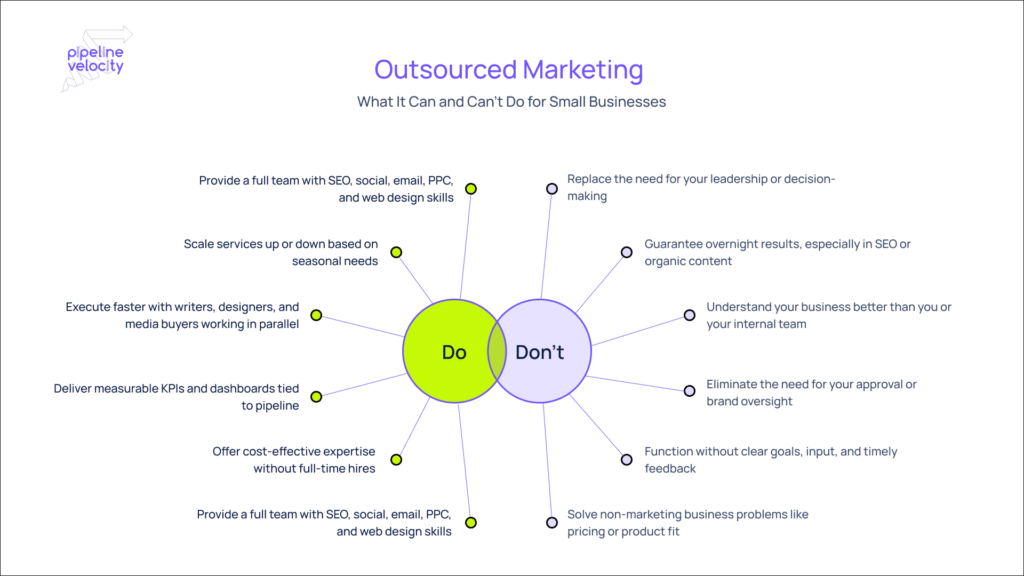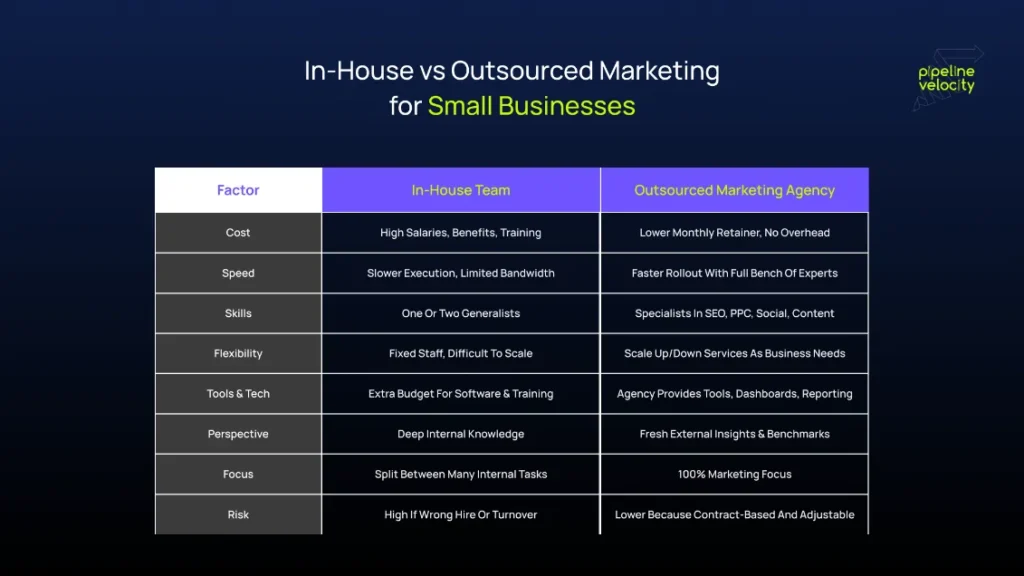Outsourced marketing for small business works best when you need expert help without hiring full-time staff. Most owners ask about costs, service scope, and speed to results. A solid partner covers strategy, SEO, content, email, social, PPC, and web. Typical small businesses start with a three-month sprint, then scale to ongoing programs. You can keep brand control while a team produces assets you approve. Clear goals, weekly check-ins, and dashboards keep everyone aligned. You can test new channels faster, trim what does not perform, and double down on what brings qualified leads. If your sales team needs steady pipeline, an outsourced marketing team can build it and prove it. Your plan should cover Instagram, Twitter, and TikTok with creative that fits each feed. You gain outsourcing services that slot into your stack without adding headcount.
How to Know if Your Small Business Needs Outsourced Marketing
You run a tight shop, and you want growth without guesswork. This section lays out simple signals that show when outsourced support makes sense, and it explains how a partner can lift the load while you keep control. You will see where common bottlenecks crop up, how wide the modern workload runs, and why focus on core business activities beats juggling every channel alone.
Signs your in-house marketing team can’t keep up
Your calendar stays full, yet campaigns go live late. The backlog grows as you try to handle content, SEO, email, social media, design, and analytics at once. Your in-house team works hard, but bandwidth caps progress and morale dips. You see missed posting schedules, thin blog posts, and slow site updates. Sales asks for new case studies and product sheets, and you cannot deliver on time. An outsourced marketing company adds hands, skills, and structure so you meet deadlines and raise quality.
When marketing tasks span wide from SEO to social media
Modern small business marketing spreads across search engine optimization, website development, content creation, email marketing, and paid ads. Social media management alone now includes short video, stories, live sessions, and cross-posting. Each channel needs a plan, a calendar, and reporting. A small internal team rarely holds all the specialized skills. An outsourced marketing partner supplies search, copy, design, analytics, and media buying in one place. You get breadth with depth and one lead strategist who ties it all to your goals. Plans for Instagram, Twitter, and TikTok differ by cadence and creative, and a good partner knows which formats convert for your buyers.
How outsourcing helps focus on core business activities
You built your business to serve customers, not to wrangle algorithms all week. Outsourcing shifts production work to a team that ships consistently. You still approve strategy, voice, and visuals. Your team can return to sales calls, service delivery, product updates, and hiring. You cut context switching and recover hours for revenue work. The partner handles marketing tasks and reports progress so you stay informed without micro-managing every asset.
What Is Outsourced Marketing and What Does It Include
Outsourced marketing means you hire an external team to plan and execute your marketing strategy. You keep ownership of goals, brand voice, and budget. The partner brings specialized skills, proven playbooks, and the staff to carry them out. You choose a scoped project or a full program that runs year round. The right fit feels like a fractional marketing department that works with your sales team and leaders every week.

Scope of outsourced marketing services from strategy to execution
A complete scope starts with discovery, target audience research, and a written plan. The team maps channels to business goals, outlines campaigns, and defines key metrics. They build a content calendar and a paid media plan. Then they execute with project management, weekly standups, and monthly reviews. You see timelines for web sprints, SEO roadmaps, email sequences, and media tests. The team sets up dashboards so you can check progress at any time.
Typical offerings: content creation, email marketing, social media management, PPC campaigns, website development, SEO, graphic design
Most outsourced marketing services include blog posts, landing pages, lead magnets, and case studies. Teams produce newsletters, lifecycle email, and marketing automation journeys. Social media packages cover channel setup, copy, creative, and community replies. PPC programs run Google Ads, paid social, and retargeting with clear budgets and pacing. Website services handle UX, web design, conversion copy, and technical updates. SEO includes keyword research, on-page optimization, internal linking, and authority building. Graphic design supports ads, brochures, trade show materials, and presentation decks. Many teams also support mobile app development when your product or booking flow lives on phones. These outsourcing services run under one point of contact so web, app, and content ship together.
How outsourcing can provide a fresh perspective and specialized skills
Outside specialists bring a clear view of your market. They benchmark your brand against direct rivals and category leaders. They suggest new angles for offers, headlines, and CTAs based on test results across accounts. The team includes search strategists, conversion copywriters, media buyers, designers, and developers. You get targeted skills on day one rather than waiting to hire and train. Fresh perspectives spark ideas your team can build on and ship fast.
Benefits of Outsourced Marketing for Small Businesses
You want a straight list of gains you can bank on. This section covers cost control, expert access, speed, and pipeline impact. You will see how an outsourced model beats hiring in certain stages and how a flexible setup supports changes in demand without drama.
Cost effective alternative to hiring full-time staff
Recruiting, salaries, benefits, software, and training add up fast. One full-time generalist still cannot cover SEO, paid media, design, analytics, and copy at a high level. An outsourced team delivers those skills under a single monthly fee. You pay for outcomes and capacity, not idle time. You can pause or scale programs with clear notice instead of carrying fixed overhead. This model lowers risk while you test channels and refine your offer. You also shave overhead costs on payroll taxes, benefits, and stacked software seats.
Access to marketing experts and holistic digital marketing services
You gain a bench of marketing specialists who live in the tools all day. The strategist ties efforts across channels so messaging stays tight from search to email to social. Designers deliver on-brand creative while developers keep the site fast and reliable. The media buyer monitors performance and shifts budget to top performers. A holistic approach prevents silos and ensures one plan guides every asset and campaign.
Scalability and flexibility to match business goals
Growth rarely follows a straight line. You may need a heavy content push this quarter, a product launch next quarter, and a website refresh after that. An outsourced marketing partner shifts capacity to match your plan. You can add a new ad network, spin up a webinar series, or expand into new regions without building a new internal team. The partner scales up or down while you keep quality and consistency. A flexibility outsourcing setup lets you scale support up for launches and trim back after peak seasons.
Speed and faster execution of marketing efforts
A coordinated team ships faster because each role stays focused. Writers write, designers design, and analysts analyze. Strong project management sets priorities and clears blockers. You approve assets inside a predictable workflow. Campaigns that took months in-house can launch in weeks. Speed compounds results because you learn sooner, cut losses, and ramp winning plays.
Improved lead generation and client engagement
The right mix of SEO, content, email, social, and paid media fills the top of the funnel. Strong landing pages and offers convert visitors into leads. Lifecycle email and remarketing bring people back. Sales gets cleaner handoffs with qualified leads and context from the activity stream. Customers see steady value through helpful content and support. Over time this builds trust, referrals, and repeat revenue.
Reasons You Might Need to Outsource Your Marketing

You do not outsource for the sake of it. You do it because your goals require more reach, more skill, or more output than your current team can deliver. This section spells out common triggers that push owners to seek an outside partner.
Limited in-house capabilities in SEO, social, email or paid ads
SEO shifts often and rewards consistent work. Social platforms change features and formats every quarter. Email needs testing across subject lines, send times, and segments. Paid ads demand tight creative, clear tracking, and daily budget control. If you lack depth in any of these channels, you waste spend and miss chances. Outsourcing plugs the gaps with specialists who focus on each area and coordinate with your team.
Need for industry experience and current digital marketing strategy
Some sectors require expert language and strict compliance. Law firms, health clinics, and financial services need precise copy and approvals. Professional services use PSM marketing methods that position experts and build trust. Tech companies need product-savvy copy and release-driven calendars that sync with sprints. A seasoned partner brings industry experience, templates, and examples you can adapt. They track current digital marketing strategy shifts so you avoid stale tactics and keep pace with buyer behavior.
Pressure to save time and cut marketing budget
Owners watch payroll and tools closely. An outsourced model can replace several hires and reduce software bloat. You cut onboarding time because the agency already runs project management, media management, and analytics stacks. You get one invoice and one point of contact. That frees cash and hours for growth projects, new hires in core roles, or equipment.
Desire for clear goals, metrics and a marketing partner
You want a marketing partner who sets clear goals, simple KPIs, and honest targets. You want dashboards that show channel health and pipeline movement. You want weekly updates that flag wins, losses, and next steps. You want to set direction, offer product insight, and approve creative without chasing the team. Outsourcing gives you that structure and rhythm so everyone rows in the same direction.
How Outsourcing Marketing Fits into Your Small Business Strategy

Marketing must line up with revenue targets, sales capacity, and product plans. This section shows how to fold an outsourced team into your operating rhythm so strategy turns into daily action.
Aligning outsourced marketing with business goals
Start with a simple scorecard. Pick quarterly goals for leads, demos, trials, or proposals. Map channels to those goals and set budget by impact. Define your ideal customer, key messages, and offers. Share sales feedback weekly so the team tunes campaigns. When strategy ties to revenue metrics, each task serves a purpose and results build in the right direction.
Setting clear expectations, metrics, and communication
Create a working agreement that spells out scope, owners, and timelines. Set one place for tasks and comments. Hold a weekly standup to review KPIs and blockers. Keep a monthly strategy review to adjust budgets and priorities. Decide how you will log ideas, share approvals, and escalate issues. Clear communication prevents surprises and keeps momentum.
Using case studies, blog posts and client testimonials to measure impact
Document wins in short case studies that show baseline, actions, and outcomes. Publish blog posts that answer buyer questions and show your approach. Collect client testimonials that focus on measurable results. These assets help sales close deals and help marketing test new angles. Over time this library proves the value of the program and attracts better-fit prospects.
In-House Marketing vs Outsourcing: What Works Best
Owners ask this question first because it shapes budget and hiring. The answer depends on stage, goals, and available talent. This section outlines clear breakpoints for each model and offers a practical hybrid approach that many small businesses use.

When to build an in-house marketing team
Hire in-house when you need daily cross-team coordination, heavy product marketing, or constant content from subject matter experts. Start with a marketing leader who can own strategy and a content marketer who can interview experts. Add a designer or developer if you ship product updates weekly. In-house teams build deep brand knowledge and fast internal communication. This model shines once you reach steady growth and can support multiple salaries.
When to hire an outsourced marketing agency or partner
Bring in an outsourced marketing agency when you need a full stack of skills without long hiring cycles. Use this model for launches, site rebuilds, SEO overhauls, and paid media programs. Agencies supply bandwidth and specialized skills you cannot hire quickly. You still set the voice and approve the work. This path helps early-stage and growth-stage teams move fast while keeping fixed costs lower than a full department.
Hybrid approaches: outsourced services and in-house coordination
Many small businesses run a hybrid model. A small internal team sets priorities and handles brand checks. The outsourced partner executes campaigns, designs assets, and manages media. Weekly syncs keep the plan tight. This setup gives you the best of both worlds. You keep control and speed while an external team carries the production and analytics load.
How to Choose a Strong Outsourced Marketing Partner
The right partner fits your goals, budget, and culture. This section shows how to vet candidates and pick one that brings results, not buzzwords.
Look for experience in small business marketing and your industry
Ask for examples that match your size, sales cycle, and average deal value. Review work for companies in your niche, such as law firms or local services. Check whether the team understands regulated language if your industry requires it. A good partner speaks your buyer’s language and knows which channels convert. Probe for expertise on your core platforms and tools. That saves time in ramp and protects your brand.
Check for specialties like social media marketing, SEO, email, PPC, web design
You do not need every service on day one, but you need a bench that can grow with you. Confirm core skills in search, content, email, paid media, and web design. Ask how they manage Google Ads budget, landing page tests, and tracking. Review sample calendars and reports. Look for consistent output and clear reasoning behind recommendations.
Demand clear communication, aligned strategy and tracking
Insist on a written plan with goals, scope, and KPIs. Require a single point of contact who runs weekly check-ins and coordinates the team. Make sure they set up analytics that tie campaigns to pipeline and revenue. Ask how they handle feedback, revisions, and new requests. Clear tracking and honest updates build trust and long-term results.
Seek client testimonials and demonstrated growth case studies
Request short case studies that show starting point, actions, and measured outcomes. Look for metrics such as qualified leads, cost per lead, pipeline value, and win rate. Read testimonials that mention speed, responsiveness, and problem solving. Strong partners share real numbers and lessons from tests that did not work. That transparency signals maturity.
Maximizing Success with Outsourced Marketing
You chose a partner. Now you want strong execution and steady gains. This section covers goal setting, workflow, and continuous improvement so you get compounding results.
Set clear goals and measure results
Define a handful of KPIs that tie to revenue. Examples include qualified leads per month, demo requests, cost per lead, and pipeline created. Set channel targets for SEO traffic, email engagement, and ad conversions. Review progress weekly and decide what to start, stop, and continue. Goals focus the team and quiet distractions.
Integrate marketing outsourcing into your workflow
Give your partner access to brand assets, product docs, and analytics on day one. Add them to your chat and project boards. Share an approvals checklist with timing and owners. Keep a content and creative intake form so requests land with context. Agree on a service-level target for turnarounds. Smooth workflow speeds delivery and reduces errors.
Use outsourced services for content marketing, automation, social strategy, SEO
Assign the team to produce cornerstone blog posts, product pages, and downloadable guides. Set up marketing automation for welcome, nurture, and reactivation journeys. Build a social content system with short clips, carousels, and posts that drive to offers. Prioritize SEO fixes that lift site speed, crawl health, and on-page relevance. The team follows SEO best practices across titles, internal links, schema, and page speed. These plays raise discoverability and conversion across the funnel.
Continuously refine efforts based on data and business growth
Review dashboards and use insights to tweak creative, bids, and budgets. Archive underperforming assets and promote winners to more channels. Test offers, headlines, and formats with simple A and B experiments. Update ICP notes as sales closes new segments. As the business grows, expand the scope to match new goals, such as partner marketing or events.
At Pipeline Velocity, We Help You Turn Marketing Into Revenue
At Pipeline Velocity, we help you convert intent into pipeline with a proven operating rhythm. For brand lift and demand creation, tap our Brand Marketing. If you want executive-level direction without headcount, use our CMO as a Service to set strategy and coach teams. Local companies that compete in New York rely on our NYC SEO to win intent-rich searches. We tie these services to dashboards and weekly reviews so you see qualified leads and revenue impact.
In summary…,
This wrap-up gives you the takeaways you can act on this quarter. Use it to plan a practical path from intent to impact.
- Strategy and scope
- Set one to three quarterly goals that tie to revenue.
- Pick channels that map cleanly to those goals.
- Write a simple plan with KPIs, budget, and timelines.
- Set one to three quarterly goals that tie to revenue.
- Team and workflow
- Use an outsourced marketing team to add skills and speed.
- Apply a flexibility outsourcing model so capacity matches seasonality.
- Keep a weekly standup and a monthly strategy review.
- Share an approvals checklist and stick to it.
- Use an outsourced marketing team to add skills and speed.
- Execution and testing
- Launch campaigns in manageable sprints.
- Test offers, creative, and landing pages.
- Shift budget to winners and cut what stalls.
- Launch campaigns in manageable sprints.
- Measurement and improvement
- Track qualified leads, pipeline, and cost per lead.
- Capture case studies and testimonials as proof.
- Adjust targets as product and market shift.
- Track qualified leads, pipeline, and cost per lead.
Wrap this plan into your operating rhythm and keep delivery tight. If you want help, partner with a team that treats your goals like theirs and shows results you can verify.
FAQs
What does outsourced marketing cost for a small business?
Most small businesses invest a monthly fee that aligns with scope and channel mix. Starter programs that cover content, SEO basics, and one paid channel often sit in a budget-friendly range. Larger programs with full media management, web sprints, and automation cost more. Pricing should include clear deliverables, hours, and targets. Ask for good, better, best options so you can scale.
How fast will outsourced marketing show results?
Paid media can move within weeks if tracking and creative are ready. SEO and content compound over months as pages rank and links build. Email and social can lift engagement within a quarter when you ship consistent value. Timelines depend on your baseline, competition, and how quickly you approve assets. A three-month sprint sets a fair initial window for learning and wins.
Do I lose control of my brand if I outsource marketing?
You keep final say on voice, visuals, and offers. Set brand guidelines and approvals at the start. Review messaging and creative before launch. Hold weekly check-ins to align on priorities and feedback. A strong partner treats your brand as if it were their own and documents choices.
Which services should I outsource first?
Start with the bottleneck that slows pipeline most. Many owners pick SEO fixes and conversion-focused content to improve discoverability. Others choose Google Ads to capture demand that already searches. If your email list sits idle, launch welcome and nurture flows. Pick one or two moves you can execute well before expanding scope.
How do I measure outsourced marketing performance?
Tie metrics to revenue. Track qualified leads, sales accepted leads, pipeline value, and cost per lead. Use channel KPIs like organic traffic, rankings for target terms, email click rates, and ad return on ad spend. Review a dashboard weekly and a detailed report monthly.






